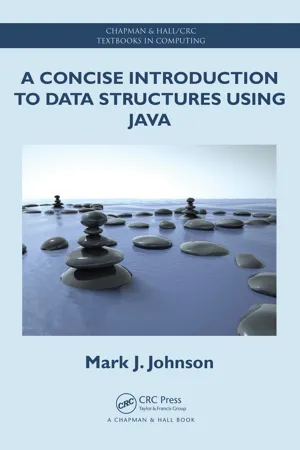
- 236 pages
- English
- ePUB (mobile friendly)
- Available on iOS & Android
eBook - ePub
A Concise Introduction to Data Structures using Java
About this book
A student-friendly text, A Concise Introduction to Data Structures Using Java takes a developmental approach, starting with simpler concepts first and then building toward greater complexity. Important topics, such as linked lists, are introduced gradually and revisited with increasing depth. More code and guidance are provided at the beginning, al
Frequently asked questions
Yes, you can cancel anytime from the Subscription tab in your account settings on the Perlego website. Your subscription will stay active until the end of your current billing period. Learn how to cancel your subscription.
At the moment all of our mobile-responsive ePub books are available to download via the app. Most of our PDFs are also available to download and we're working on making the final remaining ones downloadable now. Learn more here.
Perlego offers two plans: Essential and Complete
- Essential is ideal for learners and professionals who enjoy exploring a wide range of subjects. Access the Essential Library with 800,000+ trusted titles and best-sellers across business, personal growth, and the humanities. Includes unlimited reading time and Standard Read Aloud voice.
- Complete: Perfect for advanced learners and researchers needing full, unrestricted access. Unlock 1.4M+ books across hundreds of subjects, including academic and specialized titles. The Complete Plan also includes advanced features like Premium Read Aloud and Research Assistant.
We are an online textbook subscription service, where you can get access to an entire online library for less than the price of a single book per month. With over 1 million books across 1000+ topics, we’ve got you covered! Learn more here.
Look out for the read-aloud symbol on your next book to see if you can listen to it. The read-aloud tool reads text aloud for you, highlighting the text as it is being read. You can pause it, speed it up and slow it down. Learn more here.
Yes! You can use the Perlego app on both iOS or Android devices to read anytime, anywhere — even offline. Perfect for commutes or when you’re on the go.
Please note we cannot support devices running on iOS 13 and Android 7 or earlier. Learn more about using the app.
Please note we cannot support devices running on iOS 13 and Android 7 or earlier. Learn more about using the app.
Yes, you can access A Concise Introduction to Data Structures using Java by Mark J. Johnson in PDF and/or ePUB format, as well as other popular books in Computer Science & Programming Games. We have over one million books available in our catalogue for you to explore.
Information
Chapter 1
A Brief Introduction to Java
Before beginning our study of data structures, we take a quick tour of the main features of the Java programming language. More advanced features of Java will then be introduced as they are needed. This chapter assumes that you have some programming experience but not necessarily in Java.
A current Java Development Kit (JDK) is required to develop software in Java. All of the examples in this text were written using Java SE 7.
1.1 Basics
We begin with an example that computes factorials in Listing 1.1.
Listing 1.1: Factorial
1 public class NumericFunctions { 2 public static int factorial(int n) { 3 int result = 1; 4 for (int i = 2; i <= n; i++) { 5 result *= i; 6 } 7 return result; 8} 9 10 public static void main(String[] args) { 11 for (int n = 1; n <= 10; n++) { 12 System.out.print(n); 13 System.out.print(" "); 14 System.out.println(factorial(n)); 15 } 16} 17} Although this is a short program, it illustrates a number of features of the Java language. This section is therefore a bit longer than most, so don’t necessarily try to remember everything on first reading. Instead, notice what is here, pay attention to things that are different from what you expected, and plan to refer back to this section as questions arise.
The Java Tutorial [13] is a good resource for learning Java, as is The Java Programming Language [1]. The authoritative Java reference is the Java Language ...
Table of contents
- Preliminaries
- Series
- Dedication
- Preface
- About the Author
- Chapter 1 A Brief Introduction to Java
- Chapter 2 Algorithm Analysis
- Chapter 3 Integer Stacks
- Chapter 4 Generic Stacks
- Chapter 5 Queues
- 6 Lists
- Chapter 7 Recursion
- Chapter 8 Trees
- Chapter 9 Binary Search Trees
- Chapter 10 Heaps
- Chapter 11 Hash Tables
- Bibliography